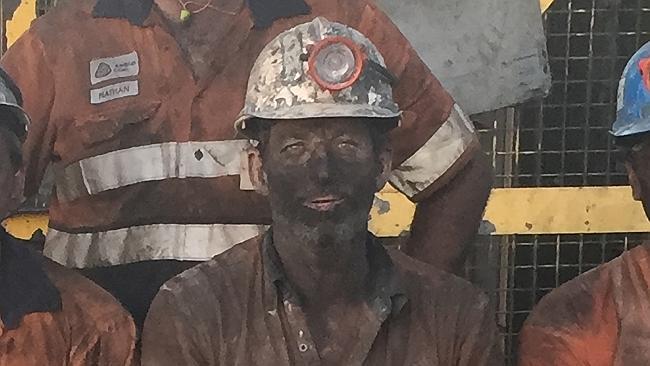
The scars on Keith Stoddart’s lungs didn’t look like ordinary cancer.
The 66-year-old coalmine technician smoked for most of his life but had given up for 18 months. Now his doctor wasn’t sure if the white markings on the x-rays revealed smoking-related emphysema or were from five decades working in underground coal mines.
Stoddart, who was suffering from stabbing pains in his chest, went to see a thoracic specialist in Brisbane, 900km from his home in Middlemount, north Queensland.
It took two biopsies, a lung function test and an agonising wait before a phone call came one Friday night with a diagnosis.
“Good news — no cancer. Bad news — Black Lung,” Stoddart told The Australian. He had been diagnosed with deadly coal workers pneumoconiosis, a disease supposedly eradicated in Australian 30 years ago. But it should never have happened that way.
As an underground coalworker Stoddart’s five-yearly x-rays are supposed to be analysed by specialists who can accurately detect and report on the disease and filed with the Queensland Department of Mines and Natural Resources.
But since Queensland’s mines minister Anthony Lynham told parliament of the first cases of the disease in three decades last December, a failure to quickly diagnose Black Lung has been revealed and glaring inadequacies in coal mine regulation and monitoring have been exposed.
It all points to a serious public health failure, and the nagging worry that the workers at the heart of Australia’s coal export industry have been tragically let down.
The coal miners’ union has floated a potential class action, claiming as many as 1000 cases could emerge following a Monash University review ordered by Dr Lynham.
Queensland’s Coal Mine Workers Health Scheme, a program in place since 1993 under state regulation, was designed to keep miners safe.
The critical elements of the scheme are the five-yearly chest x-rays for Queensland underground coal miners, and inspectors appointed by the department checking mine coal dust levels comply with legal limits.
But The Australian has revealed coal dust limits spiking to at least double legal limits at one coal mine in Brisbane’s Bowen Basin.
And now the radiology profession is on the defensive over claims Australian doctors are underqualified to properly screen for the disease compared with counterparts in the US. These claims will be tested by a Senate Select Committee on Health inquiry into the disease, which begins in Brisbane today.
Caused by inhaling fine airborne coal dust, coal workers’ pneumoconiosis is incurable but it can be controlled. Crucially, sufferers must cease any exposure to coal dust and begin pulmonary rehabilitation as soon as possible.
Says Queensland Health: “No treatment will reverse the effects of exposure to coal dust on the lungs … reduction or cessation of exposure to coal dust and other inorganic dusts is the mainstay of management of the disease.”
Put simply, health screening is the first line of defence when controlling the disease. Stoddart was working at Anglo American’s Grasstree mine near his home in Middlemount when he was last x-rayed in 2014.
But in an apparent breach of the Coal Workers scheme, the department admits in a letter to Stoddart’s solicitors obtained by The Australian that it doesn’t have a copy of the film. The 2014 x-ray report provided to Stoddart states: “The lungs and pleural spaces are clear. There is no evidence of focal or active pulmonary disease.”
Months later, the stabbing pains in the right side of Stoddart’s chest began.
Anglo American said in a statement that it “has been working closely” with Stoddart since 2012 “when an abnormality first presented”. The company confirmed while “the abnormality has been monitored closely” it “has only been diagnosed as pneumoconiosis and emphysema recently”.
“Our priority is the well-being of the employee and we are working closely with him to fully understand the diagnosis and accommodate future requirements,” the company said. “We operate in accordance with Queensland’s rigorous and transparent system of compliance on coal dust, monitoring to Australian Standard 2985 with any exposure being further managed through a hierarchy of controls to mitigate dust exposure.”
The union has sent a batch of x-rays from worried miners to the US where strict international labour organisation guidelines for analysing radiographs are mandatory for doctors who read test results from miners. This is not the case in Australia, and the union has branded the local profession substandard. In January, in the wake of the new cases and the union’s attack, the Royal Australian and New Zealand College of Radiologists issued an outraged press release saying it “refutes claims that Australian clinical radiologists lack the competence to detect pneumoconiosis in its early stages”. College president Greg Slater issued a strong defence of his profession: “Clinical radiologists in Australia have been participating in clinically appropriate and effective disease screening programs for many years — including in the area of pneumoconiosis,” he said.
“Australian radiologists are well accustomed to reporting to a checklist in the same way they do for many other procedures such as breast scans, brain scans and bone scans.”
Furthermore, “the suggestion that coal miners’ x-rays should be sent offshore to the United States … is nonsensical”.
But since the college’s press release it has emerged that Vale, the Brazilian owners of Carborough Downs mine in the Bowen Basin, where three cases were confirmed last year, is sending all of its employees’ x-rays to the US for analysis.
Vale has repeatedly failed to respond to requests for media comment, but an email sent by one of the company’s health and safety officers, obtained by The Australian, reveals Vale is undergoing “an x-ray review process”.
“All chest x-rays for current employees are being sent to a specialist … in the US to be double checked for validation purposes,” the email states.
More recently, the college’s submission to the Senate committee — which is more circumspect than its January press release — concedes that only those Australian radiologists who have chosen to do extra training in line with the ILO’s guidelines have the “experience and skill” to guarantee “accurate” and “comprehensive” reading of pneumoconiosis x-rays.
Australian “clinical radiologists have instead used standard reporting templates for diagnostic imaging when reporting on CWP”, the submission says.
This, it says, “was appropriate given that CWP had not been seen in Australia for the last 20 years”. In its submission to the Senate inquiry, the Queensland Resources Council says “workers, mining company supervisors and management, doctors radiologists, unions, government — have operated under the assumption … that this was a disease of the past”.
It is also “clear”, the council says, that the Coal Mine Workers’ Health Scheme “is not broken as six cases of CWP have been detected through the scheme”.
But the council’s defence of the scheme is undermined by Monash University Professor Malcolm Sim who is conducting the Queensland government review.
“None of the cases had been detected within the existing coal mine workers’ health scheme,” Professor Sim tells the inquiry in his submission to the Senate.
“Therefore it is imperative that the design and operation of the … medical assessments performed under the Coal Mine Workers’ Health Scheme be reviewed.”
Professor Robert Cohen, an international expert flown to Australia to consult on Professor Sim’s review, tells The Australian it is “astounding” to suggest Australia was ever free of the disease.
“It was strange to me that Australia thought it had eradicated the disease,” he says. “Because you’re still mining quite a lot of coal, you have humans, you have coal mines, it would have been a stretch to think there was no disease.”
It is far more likely, Professor Cohen says, “there was a laxity in the surveillance”.
After 30 years with no reported cases, the Queensland government has confirmed six in two months, and is on notice that two more are imminent. Says Professor Cohen: “We’re not in a position to know the severity or prevalence given the data hasn’t been looked over.”
Encouragingly, “Australia has all the infrastructure to fix things up quickly”, he says. “You have world-class technology but that special bit of training and orientation and oversight might have been a bit lax … or they became complacent.” Weeks after announcing the new cases, Dr Lynham told the public that eight of Queensland’s 10 underground coal mines over the past 12 months had breached legal coal dust limits.
“All of these mines including Carborough Downs coal mine are now currently demonstrating compliance with dust management standards,” a department spokesman says.
“Mines inspectors will continue to closely monitor mines to ensure they continue to demonstrate sustained compliance over coming months.”
But Dr Lynham has not yet agreed to the union’s demand for inspectors charged with checking dust levels in mines be independent. Data provided to The Australian, which the union says was leaked from Carborough Downs, shows limits could have exceeded four times legal limits as far back as 2011.
Back then, coalminer Ian Hiscock worked at Carborough Downs in a longwall crew. He is giving evidence to the Senate today where he is likely to paint a disturbing picture of safety standards, with longwall operators standing in permanent dust on the “tailgate” of the shearer (cutter).
“There was always an operator in the dust constantly,” Hiscock tells The Australian. “There was that much leakage in the seals from the mines, that we just couldn’t get any more air,” he adds.
“Carborough Downs had a leakage problem in its ventilation seals. We were always asking management for more air … fighting for more air.”
He’s been told the mine manager made changes to longwall operations after the intervention from the department in the wake of the Black Lung cases.
But he had left by then, and after a brief stint at Anglo America’s Grasstree quit a promising career in mining at the age of 46. He now works as a prison officer.
“I decided that enough was enough and my health and family came first so I quit the industry,” he says.
“I dropped $110,000 a year but so much happier now.”
Troubled by a nasty cough, Hiscock asked his former employer, Vale, in January to send his last x-rays to the US as part of its review.
But, despite almost nine years spent underground with the company from the time the mine opened in August 2006, Vale told Hiscock past employees are not being screened for the disease. The union has agreed to send x-rays taken privately to the US on Hiscock’s behalf.
Keith Stoddart’s x-rays, too, have gone off to the US for analysis and a full report.
Although he finally received a diagnosis in Australia early this year, Stoddart is still waiting for an accurate prognosis.
Only then will he know how long he has to live.
Coal Workers Pneumoconiosis (CWP)
SYMPTOMS: Shortness of breath, a chronic cough, coughing up black mucus, high blood pressure, heart problems, increased susceptibility to auto-immune conditions such as rheumatoid arthritis and scleroderma (excessive hardening of the skin).
Ultimately, progressive massive fibrosis leads to premature death.
CAUSE: Cumulative long-term exposure to very fine airborne coal dust. The disease has a long latency stage.
TREATMENT:Ceasing exposure to coal dust immediately and implementing a pulmonary rehabilitation regime
CURE:None



